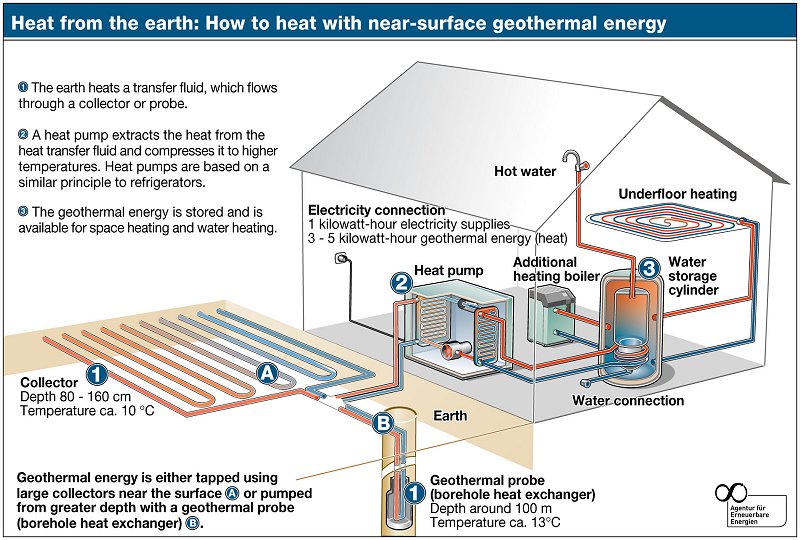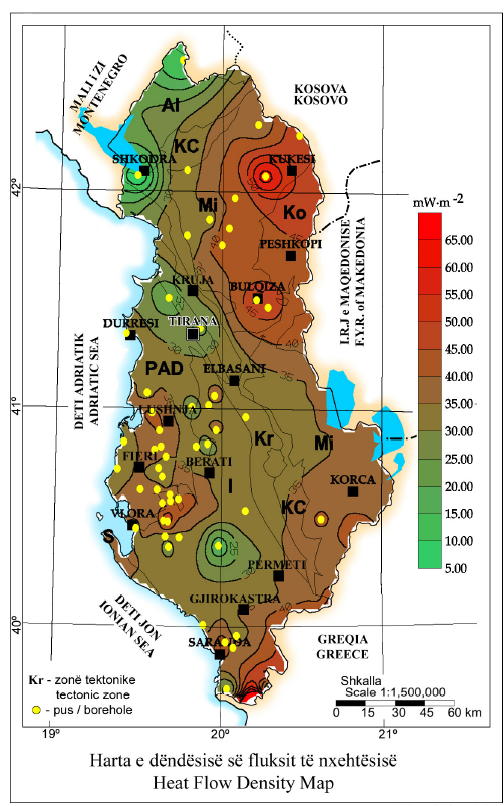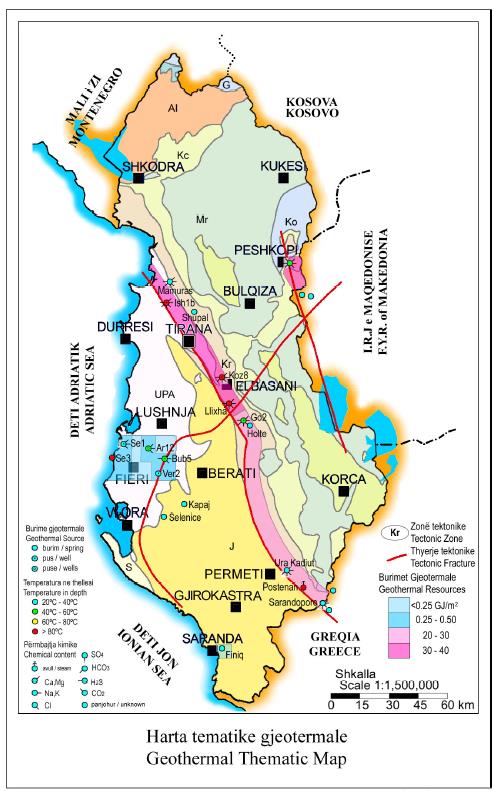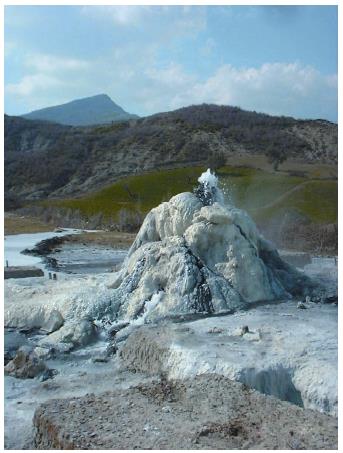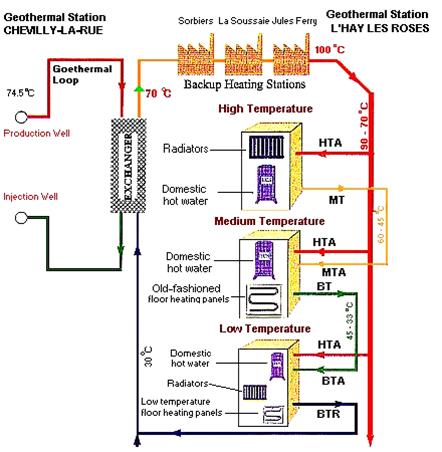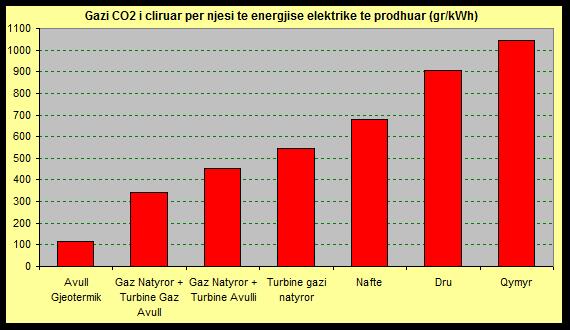GEOTHERMAL ENERGY RESOURCES IN ALBANIA
Introduction: Energy Supply in Albania
Even for a country like Albania where over 95% of electricity and 20-23% of total primary sources are provided by hydro, use of other renewables is important because improves security of energy supply and energy sector sustainability. If we add to these positive facts reduction of foreign trade deficit for any net importer country – and Albania is such a country – it is clear why an analysis of the status of RE development in comparison with other similar countries is important too.
Worldwide, in the last decade, most of the debate concerning the promotion of renewable sources was focused on the financial support schemes and on improving grid access conditions for renewable electricity. No doubt, these are essential issues which will continue to be in the center of policy makers’ attention now and in the future. However, during the last few years, “the importance of” identifying and “tackling non-financial and non-technical barriers to renewable electricity has attracted attention of analysts” and governments.
According to the most recent energy balance for Albania issued by International Energy Agency (IEA) – for 2008 – from a total net consumption of primary energy sources of 2088 ktoe only a equivalent of 333 ktoe are generated by hydro and other RE sources, so a share of 15.9 %. The biomass contribution in TPES was about 10%.
- Geothermal energy in Albania in general as well as in main parts of Korca Prefecture in particular
Geothermal resource consists of underground layers or springs that contain water with a temperature level which is enough to gain useful forms of energy. Usually, the water is heated through the highest temperatures in the earth core. The water temperate level can be used in the buildings for heating in low temperature directly or with the help of heat pumps. In case of very high temperatures or when the water is in the form of steam, electricity is produced. Here, focus is on the utilization of geothermal resources for heating purposes, where it is expected that most resources are on a moderate temperature level, i.e. they need to be ‘thermally treated’ by heat pumps.
Albanidet represent the main geological structures laid out in Albanian territory in general as well as in main parts of Korca in Particular. They are localized between Dinaridëve in the north and Helenidëve in the south. Together they form Dinarik Branch of Mediterranean Alpine Belt. In the depth up to 500 m, the temperature is 12-15°C and over 500 m is 21-41°C. In the depth 6000 m in the center of the sedimental ponds the temperature goes up to 105.8°C. In this pond geothermal gradient is about 18.7 mK/m.in the south direction, in the Ofiolitik belt the gradient has maximum values abot 32.2 mK/m. Geothermal situation of Albanideve offers two direction for geothermal energy using, which up to now is not used.
First, thermal sources in low enthalpy and maximum temperature up to 80°C. These are natural resources in Albanian territory from the south part of Albania near the border Albania-Greece , even in north-east part. Second, using the deep vertical wells. A considerable number of abounded gas and oil wells may be used for geothermal purposes. Actually, Albania is in the study phase for the possibilities of the exploitation of Geothermal Energy.
2 Methods use for the study
Geothermal studies made in Albania have been oriented in the studies of trying to know the distribution of geothermal fields and sources of thermal waters and wells. Also it is calculated the geothermal gradient and the density of hot water discharge from those natural geothermal resources. There have been made measurements for temperatures in 145 m deep wells and shalow ones, in mines in different levels.
The temperature in the wells has been registered in regular intervals. Absolut mistake from the measurements is 0.3°C. The measurements have been carried out in the sustainable regime of wells filled with water and clay. The collected data have been registered and processed, using analyses of the first and second grade. There have been founded even the chemical components of the water. It has been assessed the hydrology compound of the resources and wells.
For any country, energy renewable sources development is important because helps country to fulfill at least 2 of its strategic objectives: security of supply and sustainability. However, Albania is a special case because its electricity generation is done in large majority using hydro big and medium sized power plants. Also, about 10-13% of the Total Primary Energy Sources (TPES) of the country – including imports – are provided by biomass, especially wood for fire.
However, the country’s reliance on hydropower makes it vulnerable to changes in hydrologic conditions, as witnessed during a period of drought in 2007, 2011and this reduced dramatically the electricity security of supply. In this respect, the World Bank organized a conference to analyze increased risk of bad hydrology as effect of climate change in Albania[2]. Even if the next following 3 years (2008, 2009, 2010) recorded normal hydrological conditions, the threat still remains, since it is almost clear that power generation from hydro on ongoing year (2011) is lower than average. Another difficulty is the continuing delay of hydro power plants equipment rehabilitation that carries to the reduction of their energy availability.
On the other hand, Albania has important imports of energy which vary – depending on yearly conditions – between 30 and 60% of TPES. Renewable energy can be a solution for reducing this strategic dependence on imports and improve not only security of energy supply but also country’s economic and political macro security by decreasing country’s budget deficit. Finally, development of renewable energy projects attracts foreign investment and generates new jobs for a Albania with lower level of income per capita.
According to the most recent energy balance for Albania issued by International Energy Agency (IEA) – for 2008 – from a total net consumption of primary energy sources of 2088 ktoe only a equivalent of 333 ktoe are generated by hydro and other RE sources, so a share of 15.9 %. The biomass contribution in TPES was about 10%.
- Geothermal energy in Albania in general as well as in main parts of Korca Prefecture in particular
Geothermal resource consists of underground layers or springs that contain water with a temperature level which is enough to gain useful forms of energy. Usually, the water is heated through the highest temperatures in the earth core. The water temperate level can be used in the buildings for heating in low temperature directly or with the help of heat pumps. In case of very high temperatures or when the water is in the form of steam, electricity is produced. Here, focus is on the utilization of geothermal resources for heating purposes, where it is expected that most resources are on a moderate temperature level, i.e. they need to be ‘thermally treated’ by heat pumps.
Albanidet represent the main geological structures laid out in Albanian territory in general as well as in main parts of Korca in Particular. They are localized between Dinaridëve in the north and Helenidëve in the south. Together they form Dinarik Branch of Mediterranean Alpine Belt. In the depth up to 500 m, the temperature is 12-15°C and over 500 m is 21-41°C. In the depth 6000 m in the center of the sedimental ponds the temperature goes up to 105.8°C. In this pond geothermal gradient is about 18.7 mK/m.in the south direction, in the Ofiolitik belt the gradient has maximum values abot 32.2 mK/m. Geothermal situation of Albanideve offers two direction for geothermal energy using, which up to now is not used.
First, thermal sources in low enthalpy and maximum temperature up to 80°C. These are natural resources in Albanian territory from the south part of Albania near the border Albania-Greece , even in north-east part. Second, using the deep vertical wells. A considerable number of abounded gas and oil wells may be used for geothermal purposes. Actually, Albania is in the study phase for the possibilities of the exploitation of Geothermal Energy.
2 Methods use for the study
Geothermal studies made in Albania have been oriented in the studies of trying to know the distribution of geothermal fields and sources of thermal waters and wells. Also it is calculated the geothermal gradient and the density of hot water discharge from those natural geothermal resources. There have been made measurements for temperatures in 145 m deep wells and shalow ones, in mines in different levels.
The temperature in the wells has been registered in regular intervals. Absolut mistake from the measurements is 0.3°C. The measurements have been carried out in the sustainable regime of wells filled with water and clay. The collected data have been registered and processed, using analyses of the first and second grade. There have been founded even the chemical components of the water. It has been assessed the hydrology compound of the resources and wells.
Geothermal studies have been layed out in all Albanian territory. In the west part, where the oil and gas reserves are located, the temperature is registered in 120 wells. In the north-east and south-east part have been studied about 25 drilling and 8 thermal water resources. Also chemical analyses has been carried out.
3 Results
Results of geothermal studies have been shown in the maps and geothermal sections. Temperature maps have been collected in different level up to 5000m depth. Also have been created geothermal gradient maps and hot flow density for Albania in general as well as in main parts of Korca in particular. In the following, author has prepared three important maps which are the basic parameters of geothermal energy for Albania in general and for Korca in particular.
4 Geothermal areas and their reservoirs
There are a lot of thermal wells and sources with low enthalpy in Albania in general as well as in main parts of Korca in particular. The temperature of the water goes up to 60°C. These thermal water resources are located mainly in the regions with tectonic fracture. The water moves through carbonic rocks in several km deepth. The water of these sources contains salt, bromium jodur, absorbed gas and some organic substances. In most of oil and gas wells there are several thermal water sources which come out with a temperature of interval of 32-65.5°C.
Table 1: Geothermal resources and their main characteristics
| N° of wells | location | Temperature in °C | salt mg/l | Flow l/s |
| 1 | Llixha Elbasan | 60 | 0.3 | 15 |
| 2 | Peshkopi | 5-43 | 9 | 14-17 |
| 3 | Kranë-Sarandë | 34 | <10 | |
| 4 | Langareci-Përmet | 6-31 | 30-40 | |
| 5 | Shupal-Tiranë | 29.5 | >10 | |
| 6 | Sarandoporo-Leskovik(Korca Prefecture) | 26.7 | >10 | |
| 7 | Tervoll- Gramsh | 24 | >10 | |
| 8 | Mamurras-Tiranë | 21 | 26 | >10 |
Geothermal water resources and wells are located in three spaces (zones). Krujë, Ardenicës,and Korca area (including the Peshkopia). Also there are even separated resources. Geothermal reservoirs are located in sismic active belts locations. Thermal waters contain high free CO2, which varies from 0.004 – 0.5425 g/l for example:
- 0.004 g/l in geothermal well of Ardenica.
- 0.0783 g/l thermal resources of Mamurras.
- 0.196 g/l thermal resources of Llixhas.
- 5425 g/l thermal resources of Korca area (including Peshkopi).
- Geothermal Space of Kruja (second zone) has the biggest geothermal resources in Albania, with a total length 180 Km and width of 4.5 Km, identifying 5.9 x 108 – 5.1 x 109 The geothermal zone starts in Adriatic Sea, in the north-west part of Tirana and keep going in the south-east part in Greek territory.
- Thermal spaces of Ardenica (first zone) is concentrated in the coastline. The water comes out from the wells with a temperature 32-38°C, and flow 15-18 l/s. The thickness of water layers in Ardenica is about 900 m, starting from 1095-1955 m. Water sand layers has a thickness which goes from some cm up to 15-20 m.
- Geothermal spaces of Peshkopia-Elbasan-Korca-Leskovik Areas (including Peshkopia) (third zone) is located in the north-east part of Albania, 2 Km in the east part of Peshkopia and continue up to Leskovik. There are located some thermal resources near of each other. Flow is 14-17 l/s. Water temperature is 43.5°C.
From above mentioned analyze results that the status of geothermal regime of the surface is of such a levels that allows exploitation of their heat for heating or conditioning spaces of offices, hospitals, libraries, schools, theaters and cinemas, aero ports, even houses. The heat of these layers has caused the heating of waters of the zone.
Table 2: Main data of geothermal wells
N° | Name | Temperature në °C | Salt mg/l | Flow l/s |
| 1 | Kozani – 8 Part of Peshkopia—Elbasan-Korca-Leskovik belt | 65.5 | 4.6 | 4.5 |
| 2 | Ishmi 1/b | 64 | 19.3 | 3.5 |
| 3 | Galigati 2 | 45-50 | 5.7 | 0.9 |
| 4 | Bubullima 5 | 48-50 | 35 | |
| 5 | Ardenica 3 | 38 | 15-18 | 15-18 |
| 6 | Ardenica 12 | 32 | ||
| 7 | Semani 1 | 35 | 5 | 5 |
| 8 | Verbasi 2 | 29.3 | 1-3 | 1-3 |
Temperatures of water layers have been calculated of 145-250°C. Surface temperature is calculated from 30°C to 65.5°C. The flow is about 3.5-15 l/s.
From hot water may be produced several chemical elements like jodine, brom, clorand other natural salts, necessary for preparation of different medicaments. Sulfhidrytes and CO2 may be produced from these waters.
Based on geothermal energy capacities in Albania and also world experience according to the exploitation of this source of energy, it has to be stressed that there are possibilities in Albania in general as well as in main parts of Korca in particular for building new businesses in some directions by utilizing the geothermal resources:
Cascade and integral using of the heat of geothermal waters. Since the zones where these resources are located are urban areas in general the use of thermal waters becomes more easy. Up to now some of the thermal waters in Albania are used for medical support (Peshkopi-Elbasan-Korce-Leskovik, Bilaj of Fushkrujes). But these waters may be used also for curative purposes for different deaseses.
a) geothermal ecotourism. It has to be mentioned that in Italy geothermal complexes are visited by 2.5 milion turist /year. It may have be constructed hotels with hot water pools, with sauna, intertainment bars also in Albania especially on Peshkopi-Elbasan-Korce-Leskovik and Bilaj of Fushkruje.
b) Modern medical clinics: in order to attract tourists who like to use geothermal water building up modern clinics will be good business for the areas of Peshkopi-Elbasan-Korce-Leskovik, Bilaj of Fushkruja
c) Heating of greenhouses and the development of acquaculture
d) Releasing of useful minerals and salts.
5. TECHNOLOGIES FOR USING GEOTHERMAL ENERGY
5.1 SPACE HEATING
The wells are constructed in the garden of the houses in a distance of 8 m from each other, they are 65m deep and have hot probe made by four plastic pipes, with a diameter of 25mm, in which circulates a containing of 75% water and 25% glikopropilen (which prevent freezing). The space between the hole and probe is filled with a mixture of the cement and clay. Specific average of the location of the probe is 50W/m. Land temperature in in the deep is 10°C.
The system consists:
- Absorbing heat ground and serving as artificial “geothermal resources” through vertical wells.
- The heat is absorbed from the ground in a constant temperature and it is transported through fluid in a heating pump.
After that, it is returned to the hot probe, in order to help the circulation in the well.
5.2 CASCADE USING OF GEOTHERMAL ENERGY
Diagram shows the scheme of regional heating with distributing cascade of hot water from 90°C/70°C to 60°C/45°C and finally 45°C/30°C, which is an injected temperature.
- ENVIRONMENTAL IMPACT OF GEOTHERMAL ENERGY
To evaluate the environmental impact of geothermal energy the following figures 9 and 10 are given:
Comparing of the emission of CO2 emitted by a Geothermal THPP and a TPP using conventional fuel like (gas, wood, coal).
ÄComparing of the amount of dangerous gases (gr/kWh) through a system with solar fuel and heating pumps water/water, which work with geothermal energy.

